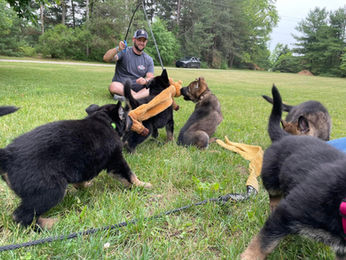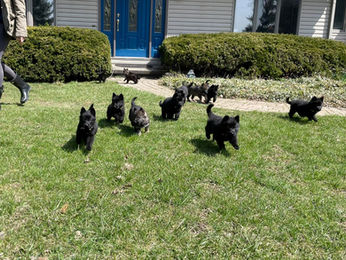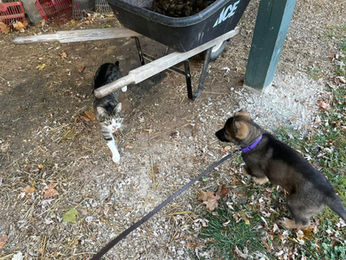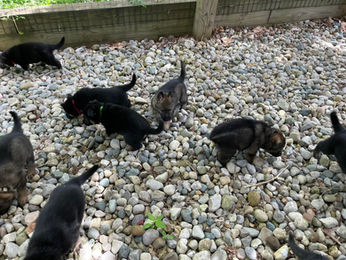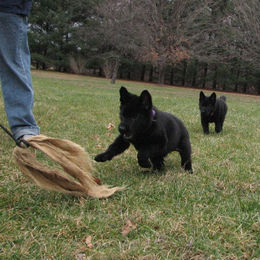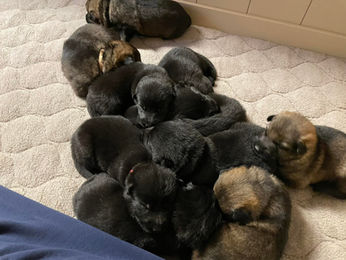How Our Puppies Are Raised
Environment & Socialization
Just as all of our own dogs live in the house with us as our companions, we whelp and raise our puppies in the house as well. Directly off our living room we have a large room, not-so-creatively dubbed "the dog room", which was built specifically for our dogs and puppies. The whelping box nestles safely in a corner, and there is plenty of space to give the dam an indoor kennel area so that she can take breaks from her puppies as needed. Once weaned, this same area allows plenty of space for a large indoor enclosure for the puppies to enjoy. Directly off the dog room is access to a large, fenced dog yard and a secure outdoor kennel so dam, and puppies once old enough, can come and go in and out as they please during nice weather.




Keeping the puppies in our home with us ensures they are in a safe, secure, clean, climate controlled area, and allows us to easily keep dam and pups under careful observation. The puppy enclosure being located right next to the living room allows the puppies to experience the everyday goings on of a normal household even when we aren't actively interacting with them. From the time their senses develop enough to allow them to do so, they see, hear and smell people, dogs, horses, cats, tractors and lawn mowers, the TV and stereo, the vacuum, pots and pans banging around in the kitchen at dinner time, the buzzer on the dryer and the overly loud and obnoxious spin cycle on the washing machine.
In addition to exposing them to everyday life, we put great effort into raising our puppies with an "Enriched Puppy Protocol". This term has been popularized (and marketed) by many behaviorists and breeders in recent years, most famously by AviDog and Puppy Culture. It isn't rocket science, but it is does require a great deal of time, attention and planning. The payoff though is huge, as anyone who has a puppy bred and raised by us can attest. So what is it? Well, it is basically the exact opposite of the sterile, spartan, almost laboratory like environment that many people think of when they envision a breeding kennel. It also takes a lot more than just keeping puppies off in a corner of the house where they experience things, but only from a distance. True enrichment requires paws-on exploration and interaction.
Thus, from day one, our puppies are exposed to new, novel things to expand their senses, get their little brains working and exploring, and to instill lifelong curiosity and confidence. With very young puppies this is as simple as having a variety of different types of blankets for their whelping box, so that daily blanket changes bring with them new smells to sniff and different textures to feel with their baby puppy toes. As the puppies grow, so do the enrichment opportunities. Toys are swapped out for new and different ones daily, so that they experience a wide variety of different sizes, colors and materials of objects to chew and carry around. The puppies find the "furniture" in their indoor and outdoor play areas rearranged on an almost daily basis. One day they might have little plush beds to sleep in, a mini agility tunnel to run through, an old plastic baby gate lying on the floor to walk over and an adventure box to play with. The next day it might be small crates to sleep in, wobble boards and saucer sleds to run over and a small children's slide to climb on. Meals are sometimes fed in community puppy pans or normal dog bowls in their puppy pen, or later in crates. Other times they might find themselves eating in an entirely new location like the kitchen, the bathtub, the basement, out on the deck. Instead of in a bowl, kibble meals might be scattered in the grass, or in a snuffle mat, or (an absolute favorite that is always video worthy) in a ball pit.
Properly enriching a puppy environment isn't just throwing new stuff at them constantly. It needs to be done with thoughtfulness and an understanding of early canine developmental stages to ensure that everything is age appropriate. We don't want to scare them. We don't want to present them with something that is overwhelming or discouraging. Challenges should be challenging, but achievable with a reasonable amount of effort. And all of it should be fun. Puppies raised in a manner where new things are safe, exciting and enjoyable, and where any obstacles in their path are surmountable, grow to become adult dogs who are bold, self-confident, curious, and always willing to try new things. These are traits everyone values in a dog, regardless of whether it's a working dog, dog sport partner, or beloved family pet.
Of course there is also a lot more to properly raising puppies than just providing them with environmental novelties. Dogs are social creatures, and interacting with other beings is of vital importance. Our pups are handled several times a day, every day, from birth until they go to their new homes. In addition to their daily cuddles, during the period of 3 to 16 days after birth they also undergo the Bio-Sensor "Superdog" Program of early neurological stimulation (ENS) that was developed by the US Department of Defense for use with Military Working Dogs and popularized decades ago by Dr. Carmen Battaglia. We also add AviDog's early olfactory stimulation to this as well. These programs are widely used by breeders of all types, and while we don't know if they truly make any positive impact in the development of young pups, they certainly don't hurt. Daily handling continues after the ENS programs are complete and we start exposing the puppies to basic husbandry tasks that will be a part of their future lives. Playing with feet, weekly nail trims/grinding, looking at teeth and ears, mild amounts of restraint, checking various body parts, some light grooming with a soft brush and baths as needed are all done in a manner that keeps these experiences, if not enjoyable, at least tolerable for the puppies in order to help set the stage for dogs who are manageable for grooming and vetting as they mature.
We do try to keep visitors and activity around the pups to a minimum until after the third week, at which time the pups' eyesight and hearing are online and they are starting to recognize and interact with other creatures. Once the puppies are ready, visitors are welcome and between friends, family members and neighbors the pups typically receive several visits a week. Customers on our puppy waiting list often come to visit too, and our schutzhund club members are always happy to socialize them on training days. By the time they go to their new homes, the pups have already met dozens of people of different ages and ethnic backgrounds.
On top of the constant parade of human visitors, our pups are well socialized with dogs through interactions with our pack of expert puppy raisers. We have been blessed with multiple generations of dogs who are happy to take on puppy babysitting duties and always enjoy puppies, providing not only additional playmates but also important lessons in canine social behavior, communication and manners.
Once old enough, the pups begin taking forays outdoors and throughout the rest of our house on a regular basis. Indoors, they get to run around on a variety of flooring surfaces (vinyl, hardwood, carpet), negotiate new obstacles like stairs, engage in typical puppy shenanigans like raiding the dirty laundry, pulling blankets off the couch and dragging the bath mats around the house, encounter bizarre objects like ceiling fans and confront large, noisy things like dishwashers and washing machines and flushing toilets up close and personal.




Outdoors, they follow us everywhere as we take them on excursions around our 10 acre property. They chase one another up and down the hillside and steps on the deck, under the bushes, around the trees, over and under logs in the woods and bales of hay in the barn. They scramble up and down piles of loose rock, dig in the dirt, play hide and seek in the flower beds, and check out the pond. They get to meet the horses and chickens and cats, and more large, noisy things like cars and tractors and lawn mowers.
As they are rampaging around like typical puppies, exploring their world with joyful abandon and enthusiasm while gaining confidence with every new experience, we aren’t just enjoying their antics and chaperoning to keep them out of trouble. We are also carefully observing them for insight into their individual personalities and taking note of any reactions or behaviors that would later be pertinent to their evaluation and placement.
Litter Box and Crate Training ~ The first steps toward housbreaking
Once puppies are old enough to start toddling away from the main sleeping area to relieve themselves, we provide litter boxes full of pine or alfalfa pellets for them to use. The pups pick up on this demarcation of areas almost immediately and within just a few days they are keeping their living and sleeping area very clean by consistently using the litter boxes. This serves two important functions. First of course it significantly reduces the mess that a litter of puppies can create, making clean up quicker and easier and providing a healthier environment overall. Second, and just as important, it encourages the puppies to keep themselves and their surroundings clean by offering the opportunity to practice, and thus reinforce, their natural instinct to relieve themselves far away from their living area. Once the pups are old enough to easily navigate between indoors and outdoors, we start taking them outdoors into the yard for potty breaks multiple times a day and also open the dog door to the outside kennel giving them access to that area as well in between potty breaks. It's a lot of work to constantly be taking a litter of puppies in and out, but it pays off quickly and usually after just a few days the litterbox isn't getting used much any longer and the majority of peeing and pooping is done outdoors. With these bathroom habits formed at a young age, further housebreaking in their new homes is a piece of cake.
At around 5-6 weeks of age we begin crate training the puppies, starting with feeding them meals in crates in order to ensure a positive first experience. The first week we will crate 2 puppies together with their food bowls in order to allow them to acclimate to the confinement of the crate without experiencing isolation at the same time. As they continue to develop and grow and get more and more used to the crates, they are separated until each pup is eating in its own, puppy sized crate. In the following weeks as their crate training progresses, we will take them for short car rides in order to accustom them to vehicular travel and help them get over any car sickness (or at least identify who gets car sick so we can warn the new owner!). As with the rest of crate training, we start with 2-3 pups together in a large crate and over time work up to pups being by themselves each in its own crate.
By the time they go to their new homes they are used to spending a few hours each day crated alone and have been on several car rides of varying durations. While it would certainly not be accurate to say our pups are fully crate trained or seasoned road travelers at this point, important steps in the right direction have been made. We have found that this early acclimation in a gradual, positive manner makes our customers' lives easier as they travel home, settle their pup in and start crate training in earnest.
Evaluation, Testing & Placement

During whelping, we record the details of each pups' birth on a log sheet, including its birth weight and information about the sex and color of the puppy and any other important notes. We then fit each pup with a different colored collar to allow for easy identification. For the duration of the pups' stay with us we continue to maintain detailed records documenting our observations and the progress of each individual puppy. Admittedly, the first couple of weeks there isn't much to take note of other than monitoring weight gain, tracking whose eyes and ears opened first, and so on. But as the pups age we are able to see more and more of each pup's unique personality, and thus our observations become much more individualized and meaningful.
Much of the evaluation process is careful observation of how the pups behave and react as they begin to explore the world and we expose them to a wide variety of new sights, smells, sounds, objects and environments. It's amazing how much information about each pup's personality can be gleaned by just sitting back and watching as they experience new things, interact with one another and with other people and dogs, adjust to the changing dynamics within the litter and learn about the world around them.
Of course, we don't just sit back to watch them play. We interact and play with them often too, both together in groups and individually. As they continue to grow and their drives, senses and coordination continue to develop, this play becomes more intense and purposeful, and also more structured using specific training toys such as tugs, leather and burlap rags and balls on strings. This play serves not only to continue to foster drive development and imprint the pups with basic skills that will prove useful later in their training careers, but it also serves as another important part of our evaluation process of the puppies. We are able to discern differences in pups between when they play together with their littermates verses playing with us one-on-one, and how the presence of littermates affects their behavior. We are able to gauge their desire to chase and grab tugs, rags and balls, their natural tendency to retrieve or possess, and their grip, willingness to counter and overall intensity and fighting behavior.
During this play, as well as at random times during our excursions around and about, we test for environmental sensitivities of various kinds. We expose them to gunshots, car horns, slammed doors, stainless steel buckets dropped on concrete, and other abrupt, loud noises in order to test their startle reflex and, most importantly, resiliency. We run them through several scenarios designed to test their drive, confidence and willingness to play despite different, strange environmental factors or obstacles. Do they play differently on slick surfaces compared to surfaces where they can get good traction and footing? How about in dark versus well lit areas? Quiet versus noisy locations? Will they confidently chase a toy up and down short flights of steps and piles off loose rock, under a table or bush, into a tunnel or through other obstacles? Will they willingly negotiate walking across a raised plank or wobble board, and up and down a lowered A-frame climbing wall? Do they remain confident, or freeze up, when placed on a table or other tall surface? When faced with an impediment to getting food or toy or anything else they want, do they keep trying, showing persistence and problem solving ability? Or do they get frustrated and have a fit, or just give up and wander off to do something else? Answers to these sorts of questions shed incredible light on the depths of each pup's personality and are important factors in determining the best placement for each pup.
We do scent work ability assessment and imprinting as well, running them through a variety of different exercises, sometimes together in groups and other times individually. One day this may involve just scattering a fistful of kibble in the grass. Another day we may hide food under a rug or towel. And yet another day we may set up formal puppy sized scent boxes complete with tracking flag, trampled ground and food scattered within the box. Then we turn them loose to search for it and sit back and take note of the answers to another host of questions: Who keeps working until it's all gone, and who gives up or looses interest quickly? Who shows calm intensity, who searches in a frantic manner, and who is more lackadaisical or easily distracted? From time to time we will even throw an environmental test into the mix as well. If a gunshot is fired overhead while the pups are searching, how do they react? Do they startle, or just keep working? If they startle, do they get back to searching and is that searching as intense as beforehand? Our observations allow us to gain insight into each pup's potential for focus and concentration, distractability, resiliency, problem solving capabilities and future work ethic.
Formal Puppy Testing
Like many breeders, we also do formal puppy aptitude testing. It has long been believed that 7 weeks of age is the ideal time to temperament test puppies. This is based upon research performed decades ago on laboratory Beagles and while the underlying research is sound, it is also limited and somewhat outdated. Furthermore, breeders of the slower maturing large and giant breeds like GSDs have often found this to be too young and that instead testing closer to 8 weeks provides more meaningful information. With this in mind, we actually do two rounds of puppy testing; one at 7 weeks and one at 8 weeks.
Formal puppy testing is conducted in a location where the pups have never been, by a person they do not know. We observe the tests, but have no involvement and keep ourselves hidden as it is important that the pups are unaware of our presence, lest it influence their behavior and thus skew the test results. Our puppy tester then puts them through a series of exercises designed to assess a wide range of different aspects of drive, nerve, resiliency and various other temperament characteristics. Both we and the tester keep detailed records of our observations of each pup's behavior on each part of the test, and later we compare notes to ensure nothing was omitted or misinterpreted.
While this puppy testing is a part of the evaluation and home placement process, it is actually only a very small part. Through everything else we have done with the pups over the previous weeks, we already have a very good understanding of each individual pup's temperament and potential working ability. By this point we even have a pretty good idea of which pup is most suitable for which customer on our reservation list. So we don't look to these tests to answer any major questions about puppies. In truth, since a puppy test is really just a snapshot in time, and no 10 minute test on any given day can provide as much insight as weeks of observation and interaction, it would be erroneous to place a significant amount of weight on puppy test results.
What we do gain from the puppy tests is the opportunity to see if the behaviors and responses that each pup has consistently shown over the proceeding weeks, and thus our expectations of how each pup will act during each phase of the tests, will hold true in the testing environment. It is very insightful to see how the pups react when they are removed from the safe, comfortable environment where they have spent their entire lives thus far and are placed with a strange person in a completely foreign location where everything looks, sounds and smells strange and where there are no littermates or familiar, trusted people around to provide support and reassurance. Are the pups rattled by this experience, or do they confidently approach it as an exciting new adventure? Do the pups maintain the same sort of drive levels and general behavioral patterns we are used to seeing at home, or does the whole testing environment cause inhibition or change in what is their normal behavior? How the pups act under these circumstances compared to what we are used to seeing from them is one of the final pieces to the puzzle of assessing temperament and working potential. This, combined with the extensive knowledge we already have of the many facets of each pup's personality, helps us consistently make successful matches of pups to new owners.
Diet, Veterinary, and Miscellaneous
Diet
All of our own dogs are fed a raw diet. While we highly recommend this diet to customers, we understand that there are a number of reasons why someone might be unable or unwilling to feed this diet. With this in mind, our litters are raised onto a diet that is half raw, and half high quality kibble, alternating between the two at each feeding. This way all the pups are familiar with and acclimated to both ways of feeding, and can easily adjust to whichever their new owners decide to feed. We are of course always willing to discuss nutrition with new owners, and help them determine the best diet to feed their new family member.
Worming and Vaccinations
Our pups are wormed regularly throughout their first few weeks and treated for other parasites as needed. We perform at least two fecal exams on the pups between 6-8 weeks of age and while typically everything is clear by this age, this is not always the case. Additionally, puppies are susceptible to parasites such as coccidia and giardia that are common in the environment, particularly in natural settings with a lot of wildlife such as where we live. Therefore we do recommend new owners have a fecal check done by their veterinarian shortly after taking their puppies home, to see if additional treatment is needed.
Puppies are given their first distemper-parvo vaccination sometime between the ages of 7 and 9 weeks. The exact timing of that vaccine is based upon nomograph results of maternal antibodies, which removes the guesswork out of when is the optimal time to vaccinate. Puppies will need one or two additional vaccinations after they have gone to their new homes in order to complete the puppy series and ensure long term immunity. For the overall health of the dogs, we use and strongly recommend Dr. Jean Dodd's minimal vaccination protocol. This means not stressing out the dog's immune system by administering unnecessary vaccinations, or vaccinating more frequently than is absolutely necessary to ensure immunity and compliance with the law.
Permanent Identification
All puppies are permanently identified with microchips before going to their new homes.
Registration and Naming
All of our puppies are registered with the American Kennel Club and the new owners are provided with the registration certificate when they pick up their puppy. All of our puppies are sold with the Limited form of AKC registration, which precludes the dog from being bred and having offspring registered with AKC. We are happy to remove this limitation and upgrade this to Full (Breeding) registration after the dog has met the breed worthiness stipulations clearly spelled out in our contract, which include working title or certification and passing hip/elbow evaluation.
We select the AKC registered name of all puppies we breed, using the German style naming system where each litter is assigned a letter of the alphabet, and the registered names of all of the pups in that litter begin with that letter of the alphabet, followed by the kennel designation of "vom Wildhaus." New owners of course are free to use any call name they desire.



















